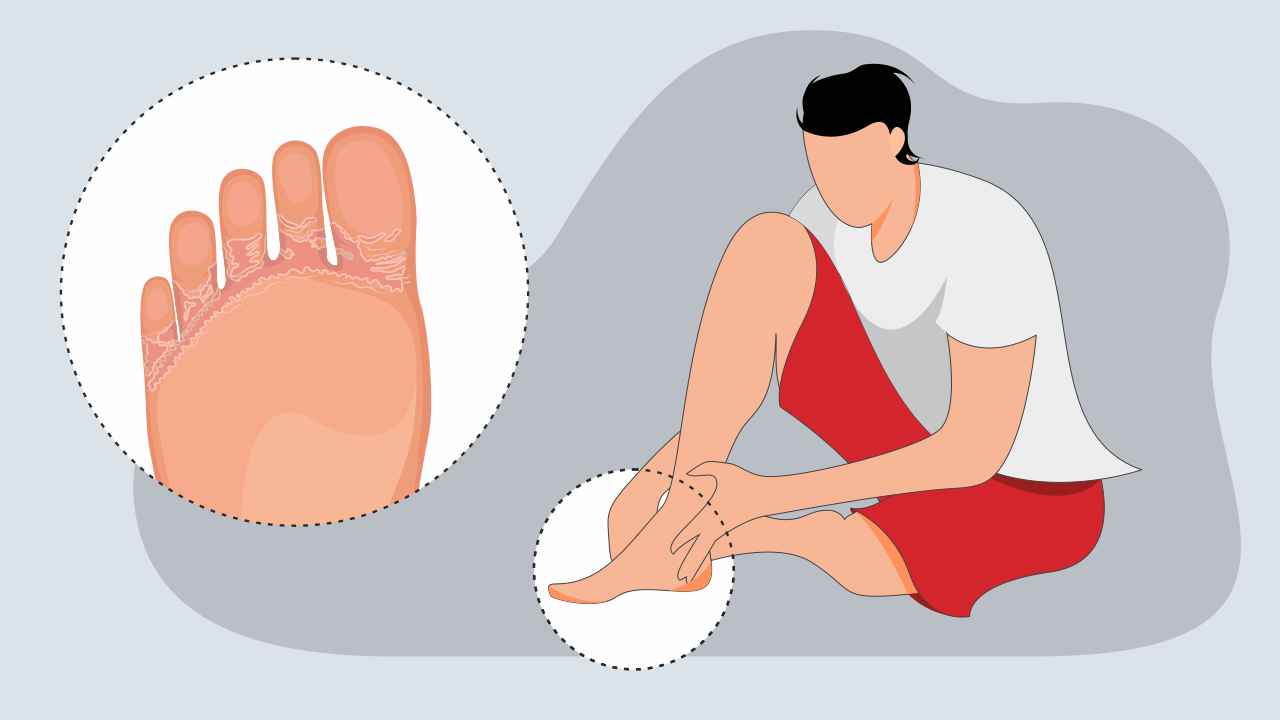
Athlete’s Foot: Causes, Treatment, and Prevention

If you are a runner or walker, you may observe a white itchy patch between your toes at some point of time. The progression of these patches can make running or walking difficult. These white patches are a fungal infection called an athlete’s foot.
Symptoms of athlete’s foot
Also called tinea pedis, an athlete’s foot is a fungal infection caused by dermatophyte fungi. The infection manifests as dry, scaly, and itchy patches or fissures between the toes. The skin turns white or cloudy yellow, thickens, and swells. It may become red, itchy, and moist. In severe cases, the skin becomes red with pus-filled blisters and an extremely foul smell. Additionally, you may experience symptoms like:
- Itching, stinging, and burning blisters on your toes and soles of the feet
- Cracking, peeling, and drying of the skin
- Discolored, thick toes that pull away from the nail bed
Though the region between the toes is mostly affected, the infection can spread to the toenails and soles of your feet. When the infection spreads to the soles, it is called Moccasin’s Athlete’s Foot.
What causes athlete’s foot?
Athlete’s foot occurs due to fungi, which thrive in dark, warm, and moist places. Fungi enter the skin through small cracks or wounds or only infect its surface. They feed on the keratin present in the epidermis, which is the top layer of the skin. Fungi can spread by direct skin contact with an infected person. Or, they may circulate through indirect contact with flakes of skin in items like socks or shoes of the infected person. Fungi can also spread from swimming pools, locker rooms, gym floors, and animals.
Who is at risk of getting athlete’s foot?
With around 15% of the population affected by athlete’s foot globally, it is a fairly common infection. While anyone can get this infection, those with these factors are more prone:
1. Biological risk factors
- Men are more susceptible than women
- Individuals with a previous history of this condition
- People with allergies and eczema
- Individuals with extremely sweaty feet
- Patients on long-term medication, which involves steroids or chemotherapy, or suffering from a disease that weakens the immune system
- Individuals with circulation problems, diabetes, or narrowing of blood vessels in the legs
2. Hygiene-related risks
- Walking barefoot in public places such as locker rooms, shower areas, and near swimming pools
- Sharing personal items such as socks, shoes, and towels with an infected person
- Wearing closed and tight shoes
- Keeping your feet wet for a long duration
- Keeping your nail or foot injury open
Also read: Foot Hygiene: Dos and Don’ts for Healthy Feet
How do you treat athlete’s foot?
Here is the procedure involved in treating an athlete’s foot:
1. Diagnosis
The doctor checks for the symptoms and examines the infected area. Most diagnoses do not require any specialized tests. Sometimes, the doctor may scrape off a small amount of skin and treat it with a chemical reagent (potassium hydroxide) to observe the sample under a microscope and figure out the fungal species.
2. Treatment
Here are a few athlete’s foot treatment alternatives:
- The doctor may prescribe over-the-counter (OTC) antifungal creams, gels, and sprays, which can stunt the growth or kill the fungi
- They may recommend antifungal tablets if the OTC products do not work
- Additionally, they may suggest soaking your feet in saltwater or diluted vinegar to dry up the blisters
Continue with the treatment for a period that your doctor advises even if the affected area has started healing to avoid a recurrence of infection. Usually, the treatment duration lasts anywhere between four to six weeks.
How do you prevent athlete’s foot?
Avoid going in a moist environment or keeping your feet wet by:
- Drying your feet well with the help of a towel after a shower or swim
- Not wearing the same socks consecutively for two days
- Wearing breathable shoes that are not very tight and have a material that encourages airflow
- Removing your shoes every few hours
- Washing and drying your shoes in the sun every few days
You may also prevent athlete’s foot by following hygiene practices, like:
- Wearing slippers and not walking barefoot in locker rooms, swimming pool areas, or places where there are public showers
- Not sharing towels, shoes, and socks
- Changing socks when your feet get sweaty
- Washing socks, bedding, and towels regularly in hot water and drying them in the sun
- Using antifungal spray or powder on your feet
Although athlete’s foot is not life-threatening, it needs to be treated in time to avert its spread to other body parts. An early detection, timely treatment, and proper practice of hygiene can help prevent it.
References
1. Athlete’s foot: Overview. Institute for Quality and Efficiency in Health Care (IQWiG), Cologne, Germany.
2. Athlete’s foot: Causes, prevention, and treatment. Harvard Health Publishing. https://www.health.harvard.edu/staying-healthy/athletes-foot-causes-prevention-and-treatment (accessed Mar 24, 2021).
3. Understanding Athlete’s Foot — the Basics. WebMD. https://www.webmd.com/skin-problems-and-treatments/understanding-athletes-foot-basics (accessed Mar 24, 2021).
4. Athlete’s Foot (Tinea Pedis). Healthline. https://www.healthline.com/health/athletes-foot (accessed Mar 24, 2021).
5. Athlete’s foot. MayoClinic. https://www.mayoclinic.org/diseases-conditions/athletes-foot/symptoms-causes/syc-20353841 (accessed Mar 24, 2021).
6. Krans B. Skin Lesion KOH Exam. Healthline. https://www.healthline.com/health/skin-lesion-koh-exam (accessed Mar 24, 2021).
7. Ringworm Risk & Prevention. Centers for Disease Control and Prevention. https://www.cdc.gov/fungal/diseases/ringworm/risk-prevention.html (accessed Mar 29, 2021).
8. Bell-Syer SE, Khan SM, Torgerson DJ. Oral treatments for fungal infections of the skin of the foot. Cochrane Database Syst Rev 2012; 10: CD003584.













